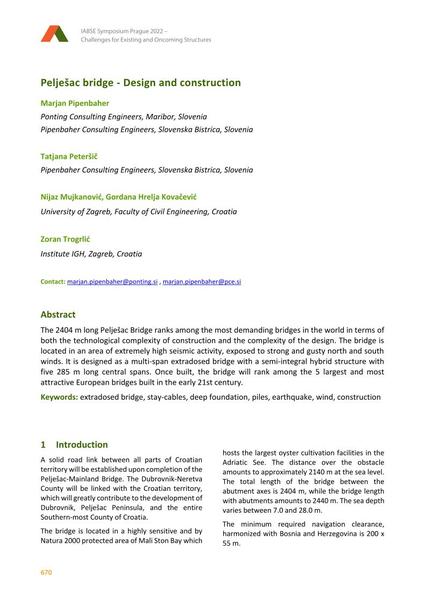Pelješac bridge - Design and construction

|
|
|||||||||||
Bibliographic Details
| Author(s): |
Marjan Pipenbaher
(Ponting Consulting Engineers, Maribor, Slovenia; Pipenbaher Consulting Engineers, Slovenska Bistrica, Slovenia)
Tatjana Peteršič (Pipenbaher Consulting Engineers, Slovenska Bistrica, Slovenia) Nijaz Mujkanović (University of Zagreb, Faculty of Civil Engineering, Croatia) Gordana Hrelja Kovačević (University of Zagreb, Faculty of Civil Engineering, Croatia) Zoran Trogrlić (Institute IGH, Zagreb, Croatia) |
||||
|---|---|---|---|---|---|
| Medium: | conference paper | ||||
| Language(s): | English | ||||
| Conference: | IABSE Symposium: Challenges for Existing and Oncoming Structures, Prague, Czech Republic, 25-27 May 2022 | ||||
| Published in: | IABSE Symposium Prague 2022 | ||||
|
|||||
| Page(s): | 670-677 | ||||
| Total no. of pages: | 8 | ||||
| DOI: | 10.2749/prague.2022.0670 | ||||
| Abstract: |
The 2404 m long Pelješac Bridge ranks among the most demanding bridges in the world in terms of both the technological complexity of construction and the complexity of the design. The bridge is located in an area of extremely high seismic activity, exposed to strong and gusty north and south winds. It is designed as a multi-span extradosed bridge with a semi-integral hybrid structure with five 285 m long central spans. Once built, the bridge will rank among the 5 largest and most attractive European bridges built in the early 21st century. |
||||
| Keywords: |
wind earthquake extradosed bridge construction deep foundation piles stay-cables
|
||||
| Copyright: | © 2022 International Association for Bridge and Structural Engineering (IABSE) | ||||
| License: | This creative work is copyrighted material and may not be used without explicit approval by the author and/or copyright owner. |
||||
